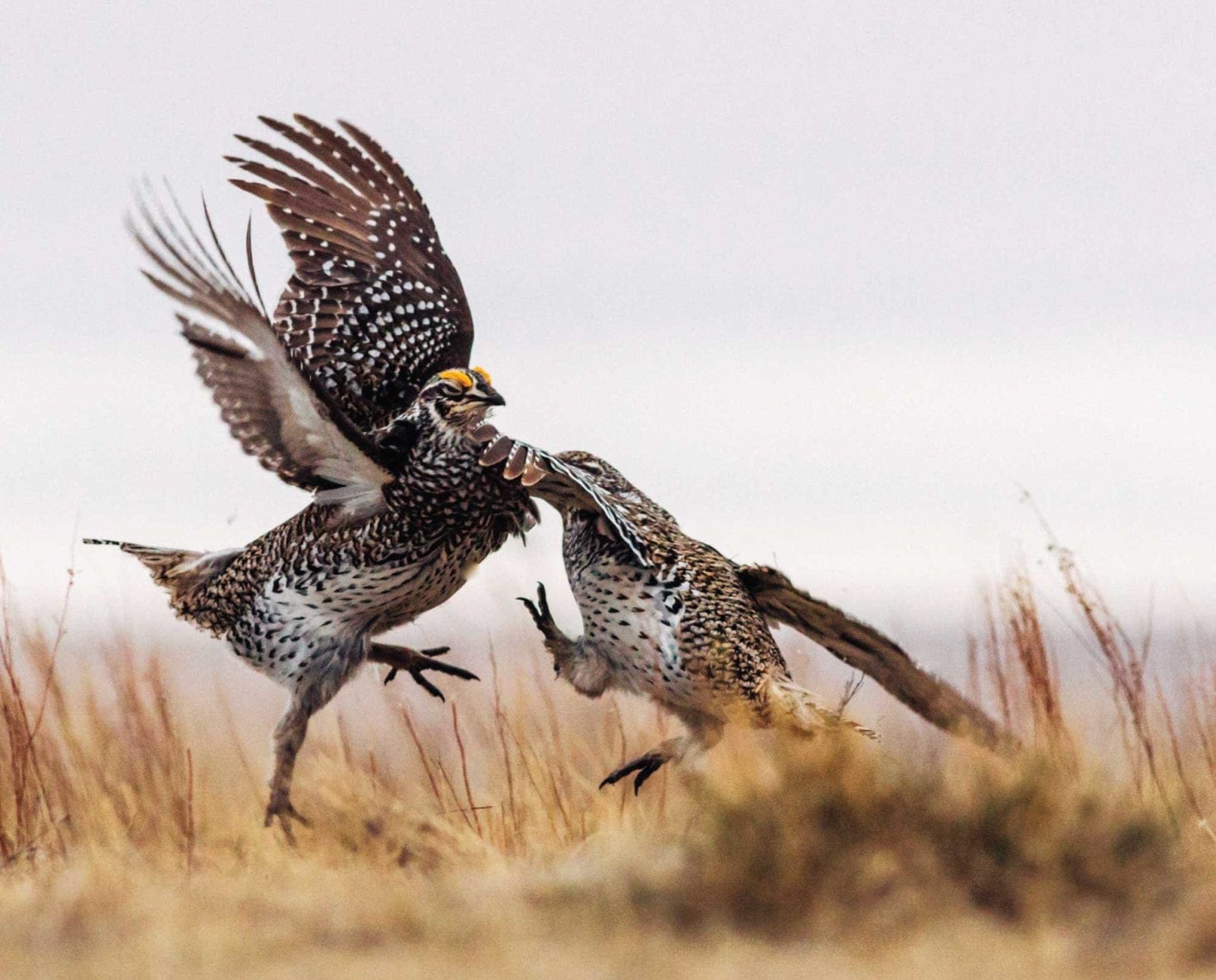Home » Grouse Species » Sharp-tailed Grouse Hunting » Sharp-tailed Grouse (Tympanuchus phasianellus) – A Prairie Grouse Overview
Sharp-tailed Grouse (Tympanuchus phasianellus) – A Prairie Grouse Overview
- Climate Change Impact (Audubon) | +1.5°C - 23% Range Lost | +3.0°C - 35% Range Lost

Ryan Lisson is a biologist and regular content contributor to…
What do you know about the northern prairie grouse known as the sharp-tailed grouse (Tympanuchus phasianellus)?
The sharp-tailed grouse is a bird of the northern prairies and shrublands. The native sharp-tailed grouse range overlaps with the introduced ring-necked pheasant, as both species require grasslands. While once very numerous in the United States, habitat loss and climate change continually shift their range northward into Canada. In fact, it is even the provincial bird of Saskatchewan.
Description and Life History of the Sharp-Tailed Grouse
The sharp-tailed grouse is generally larger than a ruffed grouse, but smaller than the greater prairie chicken, weighing in at about 2 to 3 pounds (Minnesota DNR 2018). It has a round body, short wings, and a sharply-pointed tail. Males and females have similarly colored body feathers, which are barred with brown, black and cream. Their tails are mostly cream colored, except for the long central tail feathers that are barred with brown and white. However, males have bright yellow eyebrow crests and purple throat sacks that can be inflated during courtship displays (All About Birds 2018).
The sharp-tailed grouse is a member of the prairie grouse genus (i.e., Tympanuchus). All members of this group engage in extravagant courtship displays where males gather at dancing grounds (called leks) to display for females. Beginning in April or May, up to 25 males begin their communal dancing displays to attract females (Minnesota DNR 2018). Males spread their wings and duck their heads down while lifting their pointed tails up into the air. Using stutter steps and frequently changing directions, it looks like they are pretending to be miniature, feathered airplanes. Throughout their dance, they also inflate their purple neck sacks, rattle their tails and call to females. After a female chooses a mate, she usually constructs a nest site located within one kilometer of a lek site (NatureServe 2018). The nest is a shallow depression in a clump of grass or beneath the cover of shrub species. The female will usually lay 11 to 12 eggs and incubate them for 21 to 24 days (National Audubon Society 2018; NatureServe 2018). Females will then lead the hatched chicks to feeding areas, although the chicks can feed themselves. Chicks can even make short flights at 1 to 2 weeks of age.
Sharp-tailed grouse diets change throughout the year. Freshly hatched chicks consume mostly insects (e.g., grasshoppers, ants, beetles, moths, etc.) for protein. Adults eat these insects, too, but primarily consume plant shoots, aspen and willow catkins, leaves and flowers throughout the spring and summer (NatureServe 2018). In the fall, the sharp-tailed grouse’s diet switches to seeds, waste grain, berries, and leaves. (National Audubon Society 2018). When winter snows cover the ground, the sharp-tailed grouse switches to foraging in trees and shrubs. Winter food sources include buds (e.g., serviceberry, chokecherry, aspen, etc.) and persisting fruits or berries (e.g., hawthorn, buffalo berry, snowberry, rose hips, etc.) (NatureServe 2018).
Typical predators of sharp-tailed grouse (either eggs or birds) include raptors (e.g., goshawks, great horned owls, red-tailed hawks, etc.), foxes, coyotes, minks, weasels, skunks and raccoons (Minnesota DNR 2018; NatureServe 2018).
Range and Habitat of the Sharp-Tailed Grouse
The current principal range of the sharp-tailed grouse includes Alaska, Montana, Wyoming, North Dakota, South Dakota, Nebraska and Minnesota (National Audubon Society 2018). While they also occur in surrounding states, populations are weak or imperiled. The species also lives throughout most of Canada, especially the interior plains provinces. There are several subspecies of this grouse throughout its range.
Sharp-tailed grouse habitat requires a mosaic of landscapes to really thrive. Native prairies or CRP plantings provide the grassland component they seek for nesting, displaying and cover throughout the spring and summer. However, shrublands and small pockets of deciduous trees (e.g., aspen, birch, and willow) also provide food and cover through the winter months (National Audubon Society 2018). However, if trees or shrubs become a major component in the habitat structure, sharp-tails will abandon the area. They also utilize riparian areas and agricultural fields where they occur. Lek sites are often used for many years and are located in areas with short grass species, mowed or grazed areas, natural openings or even forest clear-cuts (NatureServe 2018). While it occupies some of the same habitat and is closely related to the greater prairie chicken, the sharp-tailed grouse is able to survive much further north. It even burrows into snowdrifts to stay warm in winter, much as ruffed grouse do.
Conservation Issues for the Sharp-Tailed Grouse
The sharp-tailed grouse was apparently once so numerous that flocks could block out the sun (Minnesota DNR 2018). But vanishing habitat slowly took its effect on the species and populations crashed with the habitat loss. They are extirpated from much of their former range and now primarily occur in Northern states with adequate habitat. Their cousin the Heath Hen has even went extinct.
The primary habitat threats to sharp-tails comes from grassland conversion to agriculture, overgrazing of cattle and natural succession. Natural wildfires are very important for setting back the growth and succession of shrublands and woodlands. While we now understand that fires are critical to keeping open grassland habitat, we have suppressed natural fire regimes for decades. Fortunately, land managers now routinely use brush shearing and prescribed burns to rejuvenate sharp-tailed grouse habitat.
In recent years, climate change studies have cited concerns of rising temperatures and issues with sharp-tailed grouse nesting. The secondary concern being related to chicks with a study in Saskatchewan that showed issues of both overheating from rising temperatures and an increase in perception resulting in higher chikc mortality.
The sharp-tailed grouse is considered secure and stable across most of its range, despite significant habitat loss (NatureServe 2018). The estimated global breeding population of the sharp-tailed grouse is 600,000 birds, with about 57 percent occurring in the United States and the remainder occurring in Canada (All About Birds 2018).
Read: Modernizing Sharp-Tailed Grouse Lek Survey Methods
Hunting Opportunities for the Sharp-Tailed Grouse
There are a few states within their primary range where you can still hunt sharp-tailed grouse. Their season dates and possession limits are listed below. As always, make sure you understand the hunting regulations before you go.
| State | Season | Season/Possession Limit |
| Alaska | August 1-May 15, variable units | 10-30 birds, variable units |
| Minnesota | September 16-November 30 | 6 birds |
| Montana | September 1-January 1 | 16 birds |
| Nebraska | September 1-January 31 | 3-12 birds, variable zones |
| North Dakota | September 9-January 7 | 12 birds |
| South Dakota | September 16-January 7 | 15 birds |
| Wyoming | September 1-December 31 | 9 birds |
Sharp-tailed grouse tend to rest in open grassy cover where they can easily detect approaching predators (including you and your bird dog). That being said, they may also be found near picked grain fields and fruiting shrubs in the fall, especially during the mornings and evenings, their primary foraging times. A good dog can help scent the birds and set you up for a shot, but if you are hunting without a dog, try walking a zigzag pattern. As with almost any species, hunting earlier in the season will usually mean more relaxed birds and better shot opportunities but make sure you have the right shot size and chokes. But if you flush a few sharp-tails out of range, note where they flushed from and keep an eye on where they go. If you can quickly sneak up on the flushing point, you might be able to find another bird holding tight. If that produces no birds and you still have the energy, follow up on the flushed birds. Persistence can sometimes turn a missed shot into a heavier hunting vest.
Sources:
All About Birds. 2018. Sharp-tailed Grouse. Accessed at: https://www.allaboutbirds.org/guide/Sharp-tailed_Grouse/lifehistory
Minnesota DNR. 2018. Sharp-tailed Grouse. Accessed at: http://www.dnr.state.mn.us/birds/sharptailedgrouse.html
National Audubon Society. 2018. Guide to North American Birds. Accessed at: http://www.audubon.org/field-guide/bird/sharp-tailed-grouse
National Audubon Society. 2018. Climate Endangered. Accessed at: http://climate.audubon.org/birds/shtgro/sharp-tailed-grouse
NatureServe. 2018. NatureServe Explorer: An online encyclopedia of life. Accessed at http://explorer.natureserve.org
Ryan Lisson is a biologist and regular content contributor to several outdoor manufacturers, hunting shows, publications, and blogs. He is an avid small game, turkey, and whitetail hunter from northern Minnesota and loves managing habitat almost as much as hunting. Ryan is also passionate about helping other adults experience the outdoors for their first time, which spurred him to launch Zero to Hunt, a website devoted to mentoring new hunters.






This past season, hunting in the Nebraska Sandhills, my partners and I found very few sharpies or chickens on the same ground and habitat we hunted with more success a year earlier. The local Game & Parks guys told us numbers were way down in 2017 for reasons they couldn’t really explain. That got me wondering if they are like ruffed grouse, which my Minnesota hunting partners have told me follow a vague population cycle with seven years between peaks and valleys …
It should be noted that Michigan hosts a limited sharptail season as well.
I have hunted and killed sharptail grouse in eastern Idaho. There is a season in Idaho. These are known as Columbia sharptails. I don’t believe the birds are hunted hard in eastern Idaho, but the limit is two per day and provides a nice opportunity along with other grouse species.
Would you be able to hunt both male and female or just one?